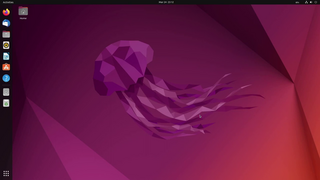
A Linux distribution is an operating system made from a software collection that includes the Linux kernel and, often, a package management system. Linux users usually obtain their operating system by downloading one of the Linux distributions, which are available for a wide variety of systems ranging from embedded devices and personal computers to powerful supercomputers.
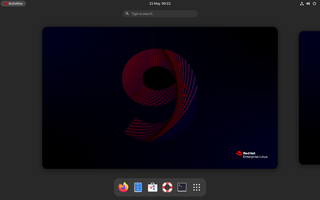
Red Hat Enterprise Linux (RHEL) is a commercial open-source Linux distribution developed by Red Hat for the commercial market. Red Hat Enterprise Linux is released in server versions for x86-64, Power ISA, ARM64, and IBM Z and a desktop version for x86-64. Fedora Linux serves as its upstream source. All of Red Hat's official support and training, together with the Red Hat Certification Program, focuses on the Red Hat Enterprise Linux platform.
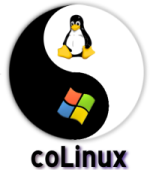
Cooperative Linux, abbreviated as coLinux, is software which allows Microsoft Windows and the Linux kernel to run simultaneously in parallel on the same machine.
Technical variations of Linux distributions include support for different hardware devices and systems or software package configurations. Organizational differences may be motivated by historical reasons. Other criteria include security, including how quickly security upgrades are available; ease of package management; and number of packages available.
Linux adoption is the adoption of Linux computer operating systems (OS) by households, nonprofit organizations, businesses, and governments.
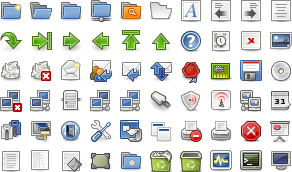
The Tango Desktop Project was an open-source initiative to create a set of design guidelines and to provide a consistent user experience for applications on desktop environments. The project created a set of icons known as the Tango Icon Library and that were described as a "proof of concept". The Tango Desktop Project was a project of freedesktop.org, and was closely linked with other freedesktop.org guidelines, such as the Standard Icon Theming Specification.
In computer security, executable-space protection marks memory regions as non-executable, such that an attempt to execute machine code in these regions will cause an exception. It makes use of hardware features such as the NX bit, or in some cases software emulation of those features. However, technologies that emulate or supply an NX bit will usually impose a measurable overhead while using a hardware-supplied NX bit imposes no measurable overhead.

A bootsplash, also known as a bootscreen, is a graphical representation of the boot process of the operating system.

Software remastering is software development that recreates system software and applications while incorporating customizations, with the intent that it is copied and run elsewhere for "off-label" usage. The term comes from remastering in media production, where it is similarly distinguished from mere copying.

Fedora Linux is a Linux distribution developed by the Fedora Project. Fedora contains software distributed under various free and open-source licenses and aims to be on the leading edge of open-source technologies. Fedora is the upstream source for Red Hat Enterprise Linux.
Comparison of the Java and .NET platforms.
Parallels Workstation Extreme is the first workstation virtualization product that lets users virtualize graphics-intensive software programs such as geophysical simulation, financial analysis, and digital content creation programs commonly used by engineers and digital animators in virtual machines on Windows and Linux hosts.
PDF Studio is a commercial desktop application from Qoppa Software to create, convert, review, annotate, and edit Portable Document Format (PDF) documents.
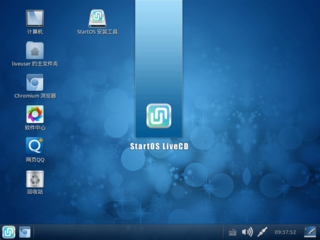
StartOS is a discontinued Chinese Linux distribution.
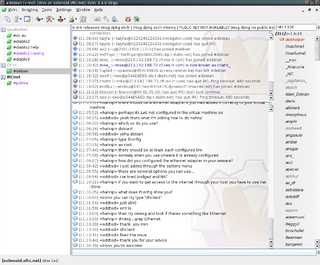
KVIrc is a graphical IRC client for Linux, Unix, Mac OS and Windows. The name is an acronym of K Visual IRC in which the K stands for a dependency to KDE, which became optional from version 2.0.0. The software is based on the Qt framework and its code is released under a modified GNU General Public License.

AirPrint is a feature in Apple Inc.'s macOS and iOS operating systems for printing without installing printer-specific drivers. Connection is via a wireless LAN (Wi-Fi), either directly to AirPrint-compatible printers, or to non-compatible shared printers by way of a computer running Microsoft Windows, Linux, or macOS. It was originally intended for iOS devices and connected via a Wi-Fi network only, and thus required a Wi-Fi access point. However, with the introduction of AirPrint to the macOS desktop platform in 2012, Macs connected to the network via Ethernet connection could also print using the AirPrint protocol—not just those connected via Wi-Fi. Direct Wi-Fi connection between the device and the printer is not supported by default, but has appeared as the 'HP ePrint Wireless Direct AirPrint' feature. It uses a proprietary page description language called Apple Raster.

Fuduntu Linux was a Fedora-based Linux distribution created by Andrew Wyatt. It was actively developed between 2010 and 2013. It was designed to fit in somewhere between Fedora and Ubuntu. It was notable for providing a 'classic' desktop experience. Although it was optimized for netbooks and other portable computers it is a general-purpose OS.

Flatpak, formerly known as xdg-app, is a utility for software deployment and package management for Linux. It is advertised as offering a sandbox environment in which users can run application software in isolation from the rest of the system.

CBL-Mariner is a free and open-source Linux distribution that Microsoft has developed. It is the base container OS for Microsoft Azure services and the graphical component of WSL 2.

Q4OS is a light-weight Linux distribution, based on Debian, targeted as a replacement for operating systems that are no longer supported on outdated hardware. The distribution is known for being similar in appearance to Microsoft Windows operating systems with some of its pre-installed themes inspired by the look and feel of Windows 2000 and Windows XP.













